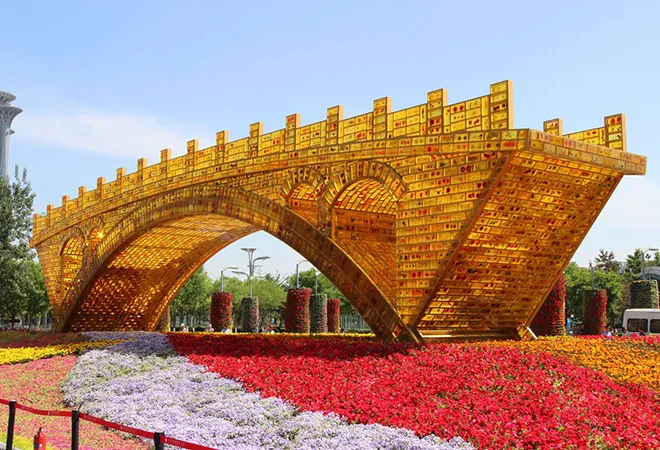 This is the seventy first article in
This is the seventy first article in The China Chronicles
series.
Read all the articles here.
It has been over five years since Premier Xi Jinping announced China’s Belt and Road Initiative (BRI) and became a major funder for infrastructure in developing countries. BRI- a
$ 8 trillion investment initiative- envisions building roads, highways, pipelines and other infrastructure projects in 68 countries, across Asia, Africa and Europe. The project offers lending for vital infrastructure financing, from Chinese policy banks China Development Bank and China EXIM bank, in developing countries.
Studies show that China’s development finance increased significantly after the global financial crisis in 2008, reaching a peak of $50 billion in 2009 and since averaging around $40 billion per year. While the initiative is packaged as a ‘golden opportunity’ for nations, it also leaves many states battling unsustainable debt. With lending practices that deploy predatory tactics and lack transparency, China has pushed countries in a ‘debt-trap’, increasing their dependence on China as a creditor and allowing them to make strategic concessions in Beijing’s favour.
Developing countries seek such levels of investment, as infrastructure development is understood as a vital engine of economic growth and prosperity. In emerging economies, governments borrowing to support investment is central to the development narrative and continues to drive growth. However, there are significant negative impacts on a country’s economy and its people, when governments incur too much debt.
A recent report has shown that there are 23 BRI countries that are at risk of debt distress according to measures of debt sustainability, with 8 countries of particular concern.
The reasons for the debt accumulation stem from the nature of China’s lending practices and the economy of the borrowing country. China does not subscribe to any guiding multilateral frameworks, set down by the International Monetary Fund or the World Bank, to define its approach to debt sustainability problems, choosing instead to deal with countries on a case-by-case basis. Its lending practices lack transparency and uniformity, and do not adhere to international standards. While BRI has coincided with the creation of Chinese-led multilateral development banks such as the Asian Infrastructure Investment Bank and New Development Bank (NDB), which adhere to a common set of debt sustainability practices, they do not reflect China’s bilateral
lending practices. As public debt rises across the developing world, traditional lenders such as the IMF are faced with the challenge of not knowing how China will respond to each country’s case. China is not a member of the
Paris Club – a group of officials from creditor countries who find coordinated and sustainable solutions to payment issues from borrower countries – making it difficult for countries who appeal to the Paris Club or the IMF for debt assistance to help.
Sri Lanka is well-known example of how a country can fall into the ‘debt-trap’ with China. In 2010, President Rajapaksa sought Chinese investment to build the Hambantota port in the country, for which China invested $1.5 billion. The following year, Colombo received a $200 million-dollar loan for a second international airport, that has since come to be known as the ‘world’s emptiest airport’, along with an additional $810 million for the second phase of the project. By 2015, Sri Lanka owed China $8 billion, with estimated that their
foreign debt to GDP ratio would rise to 94 per cent. In July 2017, with the country facing one of its worst financial crises, China agreed to a debt-for-equity swap, getting a 70 per cent stake in the Hambantota port, under a
lease agreement for 99 years. In 2011, China reportedly agreed to write off a certain undisclosed amount of
Tajikistan’s debt in exchange for 1,100 sq. kilometers of land near the Afghan border to China, a strategic junction for access to West Asia and the Indian Ocean.
Some countries are however realizing the downside of Chinese money. In 2017,
Malaysia, cancelled a $20 billion railway link and two pipeline projects that was being funded by the Chinese, because of their debt crisis. The newly elected government, coming to power on the back of a corruption scandal of the former prime minister, declared an investigation into the financing of Chinese projects in the country, announced that government debt had reached an equivalent of $250 billion.
Myanmar has rolled back plans for a $7 billion Chinese-backed port on its western coast, seeking to negotiate the terms of its deal with China. There are concerns about
Nepal falling into a similar debt trap with the government signing agreements worth $2.4 billion ranging from infrastructure and energy projects to post-disaster reconstruction efforts. In
Pakistan, which is home to BRI’s pet project - the China Pakistan Economic Corridor or CPEC- with projects nearing $60 billion, the government faces its worst debt crisis yet, with the government seeking its largest loan package of $8 billion from the IMF to bail itself out. The
country currently suffers from declining foreign reserves, a skyrocketing current-account deficit and an export to GDP ratio of below 10%, lower than other countries in the region.
It seems that borrower countries have two choices when faced with unsustainable debt crisis: cancel the projects or hand them over to China. As countries’ debt increases, so does China’s leverage over them. While China has shown a number of instances of ‘benevolence’, by cancelling a countries debt or rescheduling a payment, such as in the case of Cambodia, it has in turn ensured that the country award it contracts for additional projects in exchange. Thereby keeping the country entangled in a debt spiral.
India has remained wary of Chinese intentions with regards to its BRI projects. As it develops infrastructure in India’s neighborhood, it steadily brings nations and certain strategic locations in them, under its influence. While India understands the compulsion of infrastructure development, it remains concerned about the strategic implications of the Chinese-led initiative.
New Delhi’s primary concern is Beijing’s use of its economic presence to advance its strategic interests vis-à-vis India. This poses the challenge of managing its relationship with Beijing while competing to maintain its own influence in the region.
The success of BRI depends on the capability of the countries to actually implement and reap benefits from its projects. In turn, their implement to implement projects depends on the ability to sustain their debt and navigate successfully through BRI lending practices. Given that developing countries already hold outstanding debt from the IMF and World Bank, it is
important to consider whether Chinese liquidity will add real value and build high return projects. Should Beijing continue their debt financing model, it could bring about a worldwide debt crisis in its name. It should instead seek methods in which its investments and loans, protect the local economics of BRI, strengthen weak institutions and align with the investment practices of other major multilateral creditors. Failure to do so, will be catastrophic.
The views expressed above belong to the author(s). ORF research and analyses now available on Telegram! Click here to access our curated content — blogs, longforms and interviews.



 This is the seventy first article in The China Chronicles series.
Read all the articles
This is the seventy first article in The China Chronicles series.
Read all the articles  PREV
PREV


